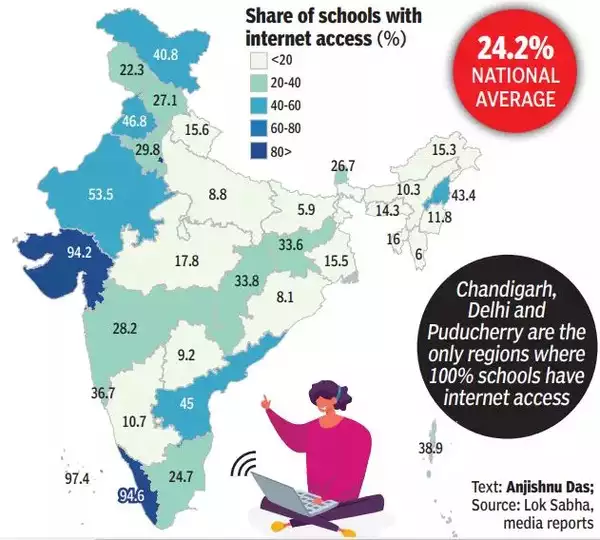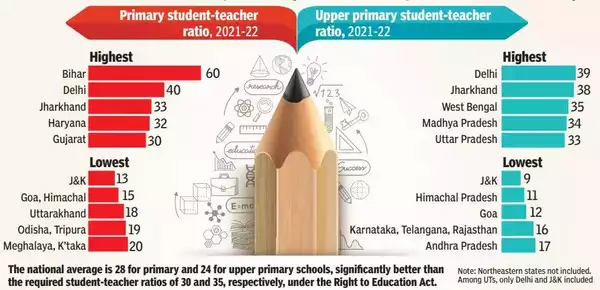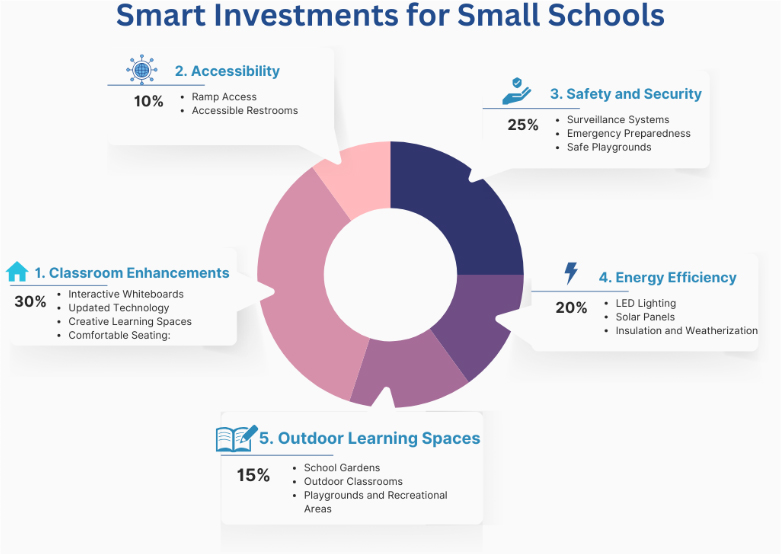
Introduction
India’s education system is undergoing a major shift to meet the rising demand for better learning solutions at all levels. However, the India Skills Report 2024 shows that only 51.25% of the country’s youth are highly employable.
At the same time, the participation rate in higher education has been rising, increasing from 24% in 2017 to 28% by 2022, according to Invest India. Small schools, on the other hand, are also very useful in providing individualized learning and creating a sense of belonging to the community.
However, there are some challenges for small schools as well, such as resource constraints, low visibility, and problems attracting high-quality teachers. This blog explains these problems in small schools and provides useful tips on how small schools can overcome the challenges and grow sustainably in the competitive education sector.
Challenges Faced by Small Schools
There are a variety of challenges for small schools that can hinder their ability to stand out in India’s competitive education sector:
-
Limited Funding and Resources
Tight budgets restrict investments in essential areas like modern teaching aids, advanced laboratories, and competitive salaries for staff. For instance, ASER reports reveal a lack of access to computers, internet facilities, and adequate libraries in many rural schools. This constraint requires innovative school competition strategies that maximize current resources and allow smaller schools to compete with larger institutions.

(Source: TOI)
-
Difficulty Attracting Skilled Staff
Budget limitations often result in inadequate compensation packages and fewer opportunities for professional growth, making it hard to hire and retain top-quality educators. Teacher Task Force studies show that staff attrition rates are higher in rural schools because of poor infrastructure and low pay. Addressing this issue requires small schools to implement smart initiatives and competitive approaches,which are essential for effective school competition strategies.

(Source: TOI)
-
Low Visibility
Smaller schools often lack strong marketing campaigns due to limited budgets, which makes attracting students a persistent issue. Declining enrollments can create financial stress, exacerbating the situation. Utilizing innovative strategies like leveraging social media, organizing community-driven events, and tapping into word-of-mouth advocacy helps improve visibility while tackling these challenges for small schools.
-
Outdated Infrastructure
Many small schools struggle with poor amenities, such as ongoing shortages in clean drinking water, proper sanitation, and adequately equipped facilities, government studies highlight. Overcoming this challenge not only improves the learning environment but also aids in improving school visibility by demonstrating a commitment to quality education. Strategic upgrades, even within constrained budgets, play an essential role in these efforts.
Also Read: How to Improve Spoken English in Private Schools in Rural India?
Developing Strategies for Effective Competition
Small schools often face unique challenges when competing with larger or more established institutions. To navigate these hurdles effectively, they must adopt smart school competition strategies that focus on their unique advantages and build a competitive edge.
- Highlight Unique Strengths: Challenges for small schools can be addressed by showcasing unique strengths, such as personalized attention, innovative teaching methods, or specialized educational philosophies. For instance, schools adopting a project-based learning model can offer interactive activities, like creating community-based science projects or entrepreneurship training, which resonate with parents seeking a holistic approach.
- Create Specialized Programs: Schools can implement programs tailored to local needs, such as bilingual instruction or advanced IT training, which not only benefit students but also boost marketing for schools through word-of-mouth. Offering extracurriculars like coding clubs or music workshops elevates the school’s profile and addresses the challenges for small schools by directly responding to parents’ expectations for enrichment opportunities.
- Strengthen Community Bonds: Developing a strong relationship with the community is a key school competition strategy. Events like parent-teacher workshops, festive celebrations, or fundraisers build goodwill and encourage families to actively engage with the institution. A connected and invested community becomes a powerful tool for marketing, further improving school visibility in both local and broader contexts.
Also Read: School maintenance and repairs: How to keep your school facilities in good condition
Effective Marketing Strategies for Small Institutions
Marketing for schools doesn’t have to break the bank. With limited budgets, small schools can deploy creative strategies to make their presence felt while addressing visibility challenges head-on.
Optimize Local SEO
A cost-effective marketing strategy includes enhancing the school’s online presence. Small schools can focus on local search engine optimization to rank higher in regional search results. Including geo-specific keywords like “affordable schools in [City]” or “CBSE school near [Landmark]” on blogs and event announcements helps overcome challenges for small schools related to visibility.
Leverage Social Media
Platforms like Instagram and Facebook are essential in modern marketing for schools. Posting regular updates, event highlights, or even student success stories draws attention from the online community, significantly improving school visibility. For example, sharing videos of school events or interviews with dedicated teachers builds emotional connections, addressing both visibility and trust issues for small schools.
Encourage Referrals and Testimonials
One of the most effective school competition strategies is encouraging current parents and students to act as brand ambassadors. Positive testimonials, especially when shared online or through local networks, increase trust in the school while expanding its reach organically.

Improving Visibility on a Budget
Overcoming visibility and other challenges for small schools often requires innovative thinking paired with practical solutions. Schools can prioritize cost-effective strategies that focus on local engagement and awareness-building.
- Organize Community Events: Hosting annual science fairs or inter-school competitions boosts a school’s visibility while showcasing its capabilities. These events position the school as an active contributor to community growth, solidifying its reputation and addressing marketing challenges for small schools.
- Highlight Achievements: Celebrating student successes in academics, arts, or sports helps create buzz, providing additional marketing opportunities. For example, local newspapers, social media channels, or even word-of-mouth marketing can significantly amplify small wins, improving school visibility further.
- Build Partnerships: Collaborations with local organizations and businesses, such as stationery shops or tutorial centres, are an inexpensive way to expand networks and resources. For example, hosting co-sponsored events builds goodwill and adds valuable opportunities for co-marketing while indirectly addressing challenges for small schools.
Infrastructure Upgrades for Better Learning Environments
Updating the infrastructure, even with limited budgets, helps small schools remain competitive while providing students with enriching educational experiences.
- Strategic Investments: Gradual yet consistent improvements, like adding tech-enabled learning tools or revamping libraries, create a significant impact without exhausting funds. Small schools can target solutions that offer high returns on both learning quality and visibility, such as installing projectors or updating sports facilities.
- Seek Support and Financing: Funding from institutions like Varthana enables small schools to overcome budget limitations for larger upgrades, such as new classrooms or playground installations. By strategically investing in infrastructure, these schools not only improve learning conditions but also address visibility and competitive challenges.
- Promote the Upgrades: Successfully executed upgrades serve as valuable marketing tools. Posting before-and-after images of new classrooms or tech-enabled labs on social media helps improve school visibility while building excitement within the community.

Also Read: Why Some Parents Prefer Private Schools Over Public Schools?
A Community-Driven Approach
A strong connection with students, parents, and the surrounding community is often the solution to challenges for small schools. A community-driven approach fosters loyalty and encourages growth through advocacy.
- Parental Involvement: Engaging parents in school activities builds relationships and improves school visibility. Hosting family events, showcasing student work, or initiating programs like parent workshops allows families to connect with the school in a meaningful way.
- Student Empowerment: Small schools should implement student-led clubs and councils to address local needs and strengthen collaboration between students and the institution. Such initiatives not only enhance leadership skills but also support marketing for schools by positioning them as proactive contributors to student development.
- External Collaboration: Partnering with NGOs or local organizations improves resource availability for schools tackling challenges, such as infrastructure or teaching constraints. These partnerships also elevate school visibility and demonstrate a commitment to holistic education.
Conclusion
Small schools can survive and thrive in a competitive environment by harnessing their unique qualities, enhancing visibility through targeted strategies, and building strong community ties. With innovative approaches and support from resources like Varthana, these institutions can establish themselves as pillars of quality education in India.





Social